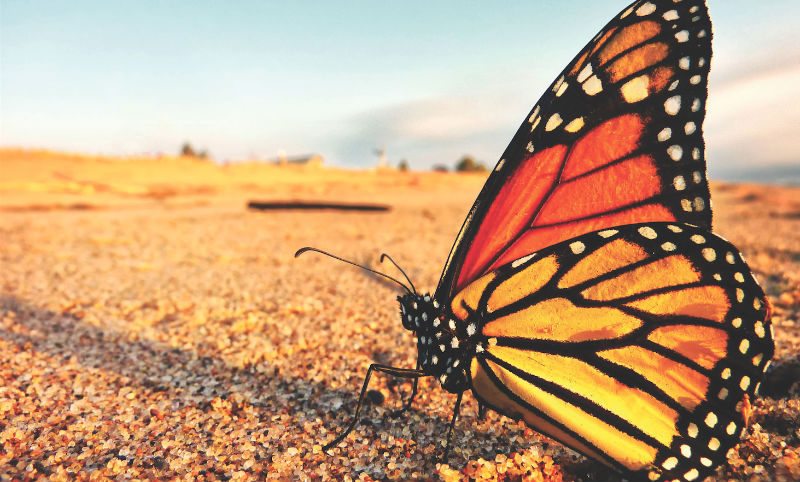
Building a Better Monarch Butterfly Waystation
The iconic monarch butterfly has been in steady decline over the past few decades. This is in part due to environmental pressures including habitat loss and fragmentation, and the dwindling availability of milkweed and nectar plants. Milkweed is not only important to monarchs because of the chemical protection it provides, but it also is the only group of plants on which the caterpillars can develop.
Restoration of populations to historical recorded levels is one of three main objectives of the National Pollinator Health Strategy (NPHS), initiated in 2015 by President Obama. Because of this, the plight of the monarch butterfly has received media attention and increased public awareness. The conservation efforts spurred by the NPHS and non-profit organizations such as Monarch Watch and The Pollinator Partnership provide business opportunities for native plant producers, nurseries and garden centers to meet the growing demand for milkweed and other pollinator-friendly annuals and perennials.

The monarch butterfly is well known for its long distance annual migrations to and from overwintering sites in Mexico, a voyage reaching upwards of 2,000 miles. The journey north may take four or five generations, with the final generation making the long trek home. These long distance flights take a tremendous amount of energy and require many stops to replenish weary butterflies. Not only is food important, but the monarchs also need breeding sites to sustain their successive generations along the way.
There are two main initiatives aimed at restoring and protecting monarch populations: 1) protecting the butterflies’ overwintering sites in the mountains of Mexico from logging and other habitat degradation and 2) reestablishing a network of milkweed and flowering plants throughout the flyways of North America to support migrating butterflies. Our research is largely focused on generating information to help landscape managers at golf courses, parks, horse farms, commercial and institutional landscapes, and other urban areas to convert unused spaces into low- input pollinator sanctuaries. It is also aimed at helping to support growers, home gardeners, garden groups and others interested in monarch conservation.
Not All Milkweeds Are Created Equal
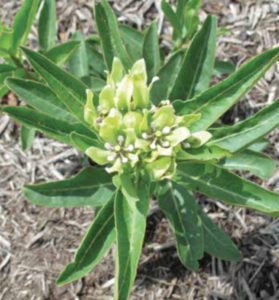
Milkweed comes in many different shapes and sizes. Species native to North America inhabit everything from swamps to deserts. They exhibit many leaf types, sizes, growth forms and flower displays. Because of the diversity of milkweed species, an obvious question arose, “Which milkweed is best for monarchs?” To answer this, in 2016 we established replicated garden plots containing eight species of native milkweeds: common (Asclepias syriaca), swamp (A. incarnata), showy (A. speciosa), butterfly (A. tuberosa), whorled (A. verticillata), spider (A. viridis), broadleaf (A. latifolia) and narrowleaf (A. fascicularis). Those species were selected because of their drought tolerance and ability to grow in full sun, traits that are necessary for low-input plantings.
We monitored the plants’ growth rates, bloom times and pod production, and their attractiveness to “wild” monarchs based on numbers of eggs and caterpillars found on each plant throughout the summer. We also caged newly hatched caterpillars on the plants and compared their growth and survival on the different milkweed species.
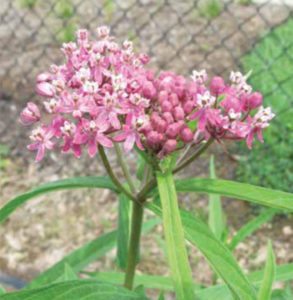
All eight milkweed species attracted monarch butterflies for egg-laying and sustained the caterpillars to adulthood. Swamp (A. incarnata), showy (A. speciosa) and common milkweed (A. syriaca) were especially attractive. Butterfly milkweed, which has bright orange flowers, was visited by many types of bees. Although butterfly milkweed grew the most robust monarch caterpillars in the cage trial, we found few eggs and larvae on the open plants, suggesting that because of the plant’s smaller stature, the butterflies may have difficulty picking it out against a background of taller plant species.
As the season progressed we observed a correlation between level of senescence and monarch choice. As the more favored milkweed species died off, wild monarchs made a shift to the somewhat less favored species. The study will be repeated in the 2017 growing season to gain more information about which milkweed species are best for monarch conservation gardens.
Gardens for Monarchs: How Small is Too Small?
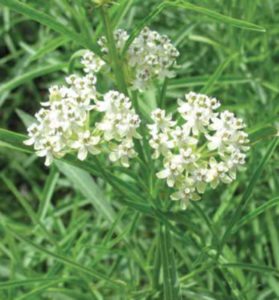
Monarch Watch, a non-profit conservation organization, encourages citizens’ planting of small butterfly gardens (monarch waystations) containing milkweeds and nectar plants. More than 15,000 certified monarch waystations have been planted by schools, churches, garden clubs, nature centers and other groups. Monarch waystations have clear educational value, but are they really contributing to the restoration of monarch populations?
To find this out, our lab initiated efforts to assess the extent to which monarchs actually find and use small butterfly gardens and monarch waystations. Bi- weekly inspections of 22 monarch waystations in central Kentucky were conducted to document the presence of monarch eggs and caterpillars. Waystations were categorized into three types: urban, peri-urban and rural. For each land type we measured structure, area, proximity to buildings, percent hardscape, milkweed diversity, lines of site and nectar plant assemblages.
We found that monarchs do find and use monarch waystations regardless of their size. The most important factors seemed to be orientation within the landscape. Rural waystations yielded (64 percent) of all monarchs observed, whereas urban sites surrounded by hardscape and traffic, and obstructed by buildings, yielded relatively few. In general, rural and peri-urban waystations tended to be larger, with a more substantial assemblage of nectar plants, so they are probably more apparent to the butterflies as they fly over the landscape. Mulched gardens, and ones in which the milkweeds stand out from the surrounding nectar plants, seem to attract more monarchs.
Par for the Course
We also are studying ways to help landscape managers establish large tracts of land with milkweed and flowering plants. For example, we are partnering with the United States Golf Association (USGA) on research to help golf course superintendents to become involved with conservation of the monarch butterfly and other native pollinators.
The 15,500 U.S. golf courses, which occupy about 2.7 million areas of land, represent a large urban and peri-urban land type, portions of which could be used for pollinator conservation plantings. Golf courses, by design, are fragmented, with patches of tall grasses, wetlands, early successional native plants and woodland separating the fairways, tees, greens and mowed roughs. A typical facility covers 150 to 200 acres, 40 to 70 percent of which is out of play. Most U.S. courses are looking to increase their proportion of naturalized areas that not only provide habitat for pollinators, birds and other wildlife, but also can lower maintenance costs by reducing the need for mowing, and for inputs of water, fertilizers and pesticides.
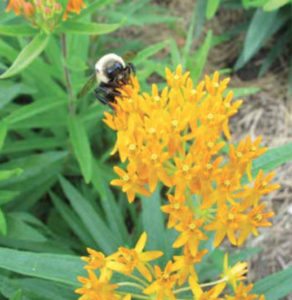
Establishing large stands of milkweed and nectar plants in naturalized roughs on golf courses could have greater conservation value than urban butterfly gardens do and Monarch Waystations that may be hard for migrating monarchs to find, and too small to support breeding populations. If half of the U.S. golf courses along monarch flyways established milkweed in out-of-play areas, that could have real conservation value by providing habitat corridors for the migrating butterflies. Stands of milkweed and nectar plants beside cart paths or around backs of tees, with interpretive signage, would offer opportunities for conservation education while providing interest while waiting to play. This could help showcase a club’s environmental stance through activities such as naturalist-led pollinator walks, or engaging with citizens involved with censuses of monarch populations.
For monarch restoration, naturalized roughs would need preferably two or three species of native milkweed as food for larvae, and a mix of early, middle and late blooming wildflowers to fuel adult breeding and migration. If desired, those areas could be mowed in early spring or late autumn, before or after the monarch migrations. Indeed, mowing can spur regeneration of vegetative shoots which can in turn increase monarch reproduction. Currently we are evaluating protocols for how best to establish large milkweed plots, and hope to encourage the USGA to put together an accreditation for participating golf courses.
Opportunities for Growers and Garden Centers
The public’s growing interest in pollinator conservation is spurring sales of flowering plants (e.g., www.millionpollinatorgardens.org). That includes demand for milkweeds and nectar plants for use in butterfly gardens and larger restoration plantings. We are studying best methods for propagating milkweeds from seed, and which species are easiest to grow, including resistance to thrips and other greenhouse pests. We’ll share those results in a future article. Conservation of monarch butterflies, and pollinators in general, provide new opportunities for growers and gardens centers to produce the plants needed to help restore the pollinator habitat already lost to degradation and urbanization.


 Video Library
Video Library 




















